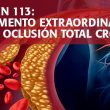During the opening ceremony of SOLACI-SBHCI 2019, the president of the Latin American Society of Interventional Cardiology, Dr. José Luis Leiva Pons, celebrated the first 25 years of our society’s life together with some of the greatest international personalities in our field (Dr. Gregg Stone, Dr. Martin Leon and Dr. Patrick Serruys) and former SOLACI...
Amount of Baseline Ischemia in Patients with Multivessel Disease and Long-Term Progress
According to this recent analysis of the MASS II trial, which will soon be published in JAMA, baseline ischemia is not associated with events at 10 years in patients with chronic stable angina. The ischemic burden induced through exercise does not predict events or long-term ventricular function. Such data add some suspense to the results...
How to Prevent Pharmacological Overtreating in the Elderly
Cardiovascular risk increases dramatically with over the years, which almost inevitable leads to treating the elderly with statins, based on risk. To prevent over treatment, we need to identify fragile patients (bed-ridden or with dementia), whose condition might make this treatment futile on the one hand, and on the other hand, patients who regardless their...
Calcium Scoring: “Location” Seems to Be More Important than “Percentage”
The presence of a high percentage of calcium in the left main coronary artery is independently associated with a 20–30% greater risk for cardiovascular and all-cause death in asymptomatic adults. This highlights the fact that calcium location, and not only amount, is important. Calcium scoring reports from computerized tomography (CT) usually inform only that: how...
Clinical Implications of the New Hypertension Guidelines
Hypertension is the first modifiable risk factor affecting morbidity and mortality in nearly half of the adults in the US. The new ACC/AHA guidelines have issued new standards for the detection assessment and management of high blood pressure. The major change compared against their prior version was stage 1 hypertension definition, defined as systolic blood...
5-Year Experience of Appendage Closure: More Evidence that Does Not Translate into Clinical Practice
The use of percutaneous left appendage closure increased 3.6-fold from 2011 to 2015, but this volume increase did not entail a significant uptrend of in-hospital events in this “real-world” population in Germany. However, can Germany be considered a real-world setting for Latin America? This question is warranted by the fact that there is no apparent...
Improved Outcomes after Lower Limb Revascularization
Operator ability combined with improved and diverse devices for lower limb revascularization has clearly increased in the last decade. However, is this technical feasibility we did not use to have translating into better clinical outcomes for patients, or is it simply inflating our interventionist egos? This study aims at answering the question above by identifying...
Next-Day Discharge after TAVR: Equally Safe for All Prosthesis?
Yet scarce, there is evidence supporting next-day discharge (NDD) after TAVR is safe when patients receiving balloon expandable valves meet certain conditions. This had not yet been shown for self-expandable valves. This study looks into NDD after TAVR by femoral access with self-expandable valves. The authors retrospectively compared all consecutive patients undergoing elective minimalist TAVR...
The Most Read Articles in Interventional Cardiology in SOLACI
1- What to Do with Blood Pressure Levels Between 130/80 and 139/89 mmHg The decision to be made with a treatment-free patient with systolic blood pressure over 160 mmHg or diastolic blood pressure over 100 mmHg is an easy one. All guidelines agree: treatment should be started immediately alongside lifestyle changes. Read also HERE 2- Low-Risk...
New ProEducar’s 113 Newsletter
The new ProEducar Educational Newsletter is out for all fellows, interventional trainees, and specialists in hemodynamics seeking to be up to date in their professional practice. This is a special issue on chronic total occlusion (CTO), one of the main current challenges for interventional cardiologists. This comprehensive, extensive work directed by Dr. Gustavo Pedernera includes...









